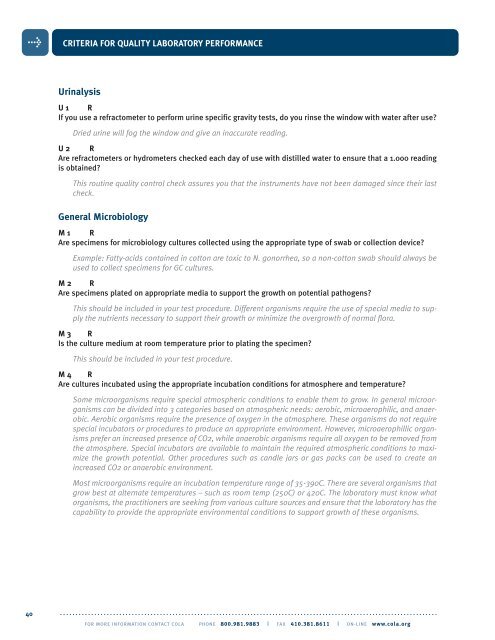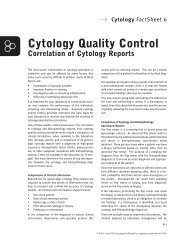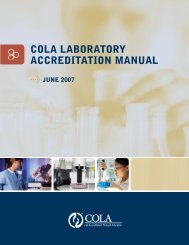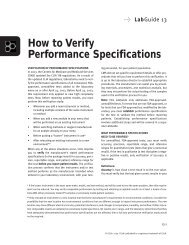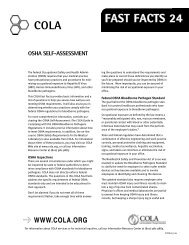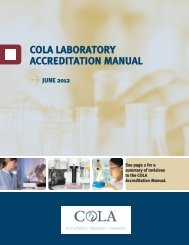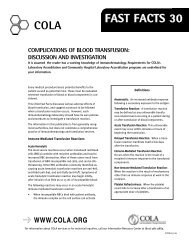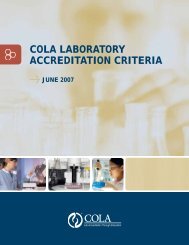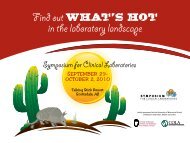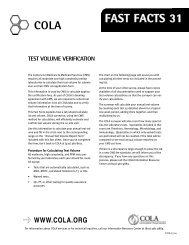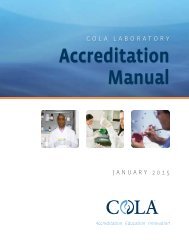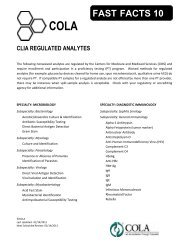#06-5558 Accrd Manual V7 - COLA
#06-5558 Accrd Manual V7 - COLA
#06-5558 Accrd Manual V7 - COLA
- No tags were found...
Create successful ePaper yourself
Turn your PDF publications into a flip-book with our unique Google optimized e-Paper software.
CRITERIA FOR QUALITY LABORATORY PERFORMANCEUrinalysisU 1 RIf you use a refractometer to perform urine specific gravity tests, do you rinse the window with water after use?Dried urine will fog the window and give an inaccurate reading.U 2 RAre refractometers or hydrometers checked each day of use with distilled water to ensure that a 1.000 readingis obtained?This routine quality control check assures you that the instruments have not been damaged since their lastcheck.General MicrobiologyM 1 RAre specimens for microbiology cultures collected using the appropriate type of swab or collection device?Example: Fatty-acids contained in cotton are toxic to N. gonorrhea, so a non-cotton swab should always beused to collect specimens for GC cultures.M 2 RAre specimens plated on appropriate media to support the growth on potential pathogens?This should be included in your test procedure. Different organisms require the use of special media to supplythe nutrients necessary to support their growth or minimize the overgrowth of normal flora.M 3 RIs the culture medium at room temperature prior to plating the specimen?This should be included in your test procedure.M 4 RAre cultures incubated using the appropriate incubation conditions for atmosphere and temperature?Some microorganisms require special atmospheric conditions to enable them to grow. In general microorganismscan be divided into 3 categories based on atmospheric needs: aerobic, microaerophilic, and anaerobic.Aerobic organisms require the presence of oxygen in the atmosphere. These organisms do not requirespecial incubators or procedures to produce an appropriate environment. However, microaerophillic organismsprefer an increased presence of CO2, while anaerobic organisms require all oxygen to be removed fromthe atmosphere. Special incubators are available to maintain the required atmospheric conditions to maximizethe growth potential. Other procedures such as candle jars or gas packs can be used to create anincreased CO2 or anaerobic environment.Most microorganisms require an incubation temperature range of 35-390C. There are several organisms thatgrow best at alternate temperatures – such as room temp (250C) or 420C. The laboratory must know whatorganisms, the practitioners are seeking from various culture sources and ensure that the laboratory has thecapability to provide the appropriate environmental conditions to support growth of these organisms.40. . . . . . . . . . . . . . . . . . . . . . . . . . . . . . . . . . . . . . . . . . . . . . . . . . . . . . . . . . . . . . . . . . . . . . . . . . . . . . . . . . . . . . . . . . . . . . . . . . . . . . . . . . . . . . . . . . . . . . . . .FOR MORE INFORMATION CONTACT <strong>COLA</strong> PHONE 800.981.9883 | FAX 410.381.8611 | ON-LINE www.cola.org


